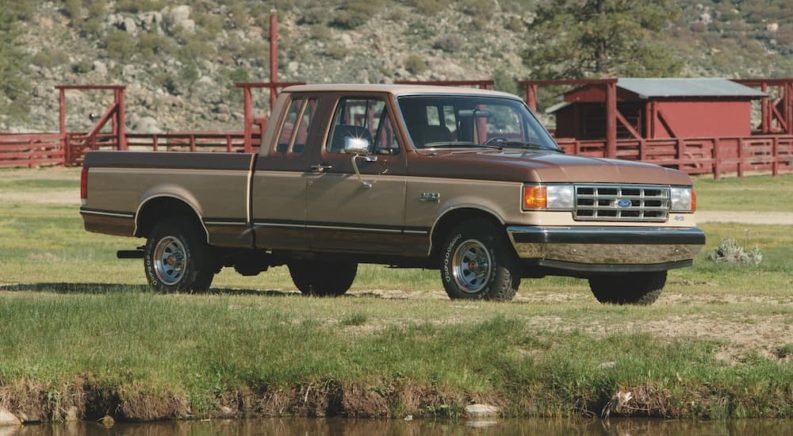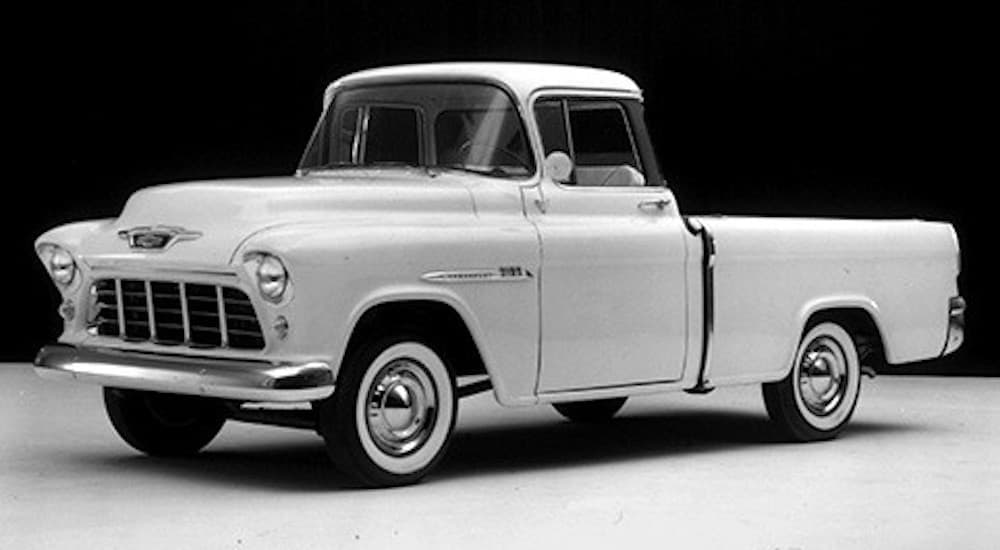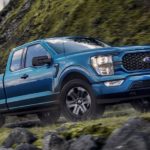Few people are likely to consider the origin of the pickup truck when they browse the lot at a Ford dealership, but a quick look at its history shows just how far trucks have come since their debut in the early 1900s. The history of the pickup truck is rife with automakers that like to brag on their influence and innovation in the design of the road warrior, but few automakers deserve that credit. Most people associate Ford with the invention of the truck, but Ford didn’t build the first model. After years of hacking up the Model T and adding boxes to the rear chassis to better serve their needs, private owners get all the credit for the design of the early truck.
Ford debuted its first truck in 1917 and put it into production in 1925. But, on a technicality, not even Ford gets credit for building the first truck. That starts in the mid-1700s with the early use of steam-powered wagons. Steam power paved the way for internal combustion vehicles–gas-powered vehicles by modern-day standards–and the introduction of the first truck in 1895 by German engineer Karl Benz. Gottlieb Daimler, often credited with inventing the truck, debuted his design a year later.
Trucks took a commercial route long before they ever became family-owned vehicles, even when Ford finally put the Model T Runabout with its Pickup Body into production. Dodge beat Ford to the punch by a slender margin, putting its wooden-bodied cab and box design on the market in 1924. Auto manufacturers duked it out fiercely to get their trucks to the market first, just like they do today.
Early Truck Capability and Designs
If we look at the power of the first Ford pickup, the Model T Runabout only made 20 horsepower with its 2.9-liter inline-four engine achieving a top speed of 42 mph. Because of the era and limited documentation, it’s hard to say precisely how much Ford’s first pickup could haul. However, we know that the Model TT was the next iteration of the pickup and was rated at one ton. Interestingly enough, drivers didn’t have to wait around for Ford to release the Model T Runabout or the Model TT to get behind the wheel of a workhorse that would meet their needs. Instead, they bought aftermarket accessories and upgrades from local companies that made it easy to customize the Model T.
Ford’s mass production of the pickup truck pushed other manufacturers to start producing their own models. Dodge and Chevy jumped into the fray and marketed their pickups in the 1930s in direct competition with Ford, expanding availability to more buyers. Once pickups were widely available from the factory and people no longer needed to build their own, companies like Marmon-Herrington innovated new aftermarket parts, including the first use of four-wheel drive. Marmon-Herrington outfitted the Ford pickup with four-wheel drive for the first time in 1935. Dodge, however, beat Ford to the punch with the 1946 Dodge Power Wagon that made history as the first mass-produced pickup truck with four-wheel drive.
During World War II, auto manufacturers retooled their factories to build airplanes, Jeeps, and other machines for the allied forces. It wasn’t until the 1950s that pickups romanced Americans into getting behind the wheel of such a practical and versatile vehicle. For decades, most buyers were using pickups for farm work or deliveries. The advent of more powerful V6 and V8 engines increased engine output to 100 horsepower; then, in 1955, Chevy introduced the Cameo Carrier, a light-duty truck flush with features like those typically found in a sedan. By 1960, most manufactured pickups followed suit with more comfortable seats, heaters, and even radios.
Dabbling with design became a common thread amongst truck manufacturers and prompted the debut of numerous body styles across the industry. For example, Ford debuted the Travelette in 1957 with its rear bench seat in the cab and third door for easier entry into the back. In the 1960s, several brands built forward-control pickups similar to the iconic Volkswagen “Bus.” The Ford Falcon Econoline and the Chevy Corvair were two models available at the time and were equipped with V6 engines and automatic transmissions. These models, however, faded by 1970 when truck manufacturers returned to a more traditional pickup design.
The rising oil crisis of the 1970s gave way to the growing popularity of diesel-powered trucks with Chevy producing its first 5.7-liter V8 in 1978, followed by Ford’s diesel-powered F-Series in 1983. While other automakers were quick to adopt diesel as a response to the growing emissions restrictions, Ford took a different approach and improved the efficiency of its gas engines. Ford’s reasoning was simple: diesel engines were loud, slow to accelerate, and produced a terrible odor. Yet, even amid this stifling atmosphere of new laws and emissions restrictions, pickup truck sales flourished with over two million units sold in 1980 alone.
Ford Trucks: Towing Capability from 1987
Surprisingly, towing a trailer wasn’t invented with the pickup truck. People have been hitching up to wagons, flatbeds, trailers, and all sorts of other unmotorized carriers for millennia. In the early 1930s, the Airstream camper debuted as American drivers happily pulled the camper with their sedans. Since trucks were utilitarian vehicles used on the farm and in industries, they weren’t an option for personal use, at least not yet.
Because of this, the towing capability of those early model trucks is hard to pinpoint. The earliest reliable record dates to Ford’s brochures for the 1987 F-150, the first year of the eighth-generation workhorse. The F-150’s available V8 engine produced 185 horsepower and offered a maximum payload of 1,500 pounds. Towing capacity for this model year topped out at 7,600 pounds, a far cry from the capability of trucks today.
Jump ahead an entire decade to 1996, and even in its ninth generation, the F-150 hadn’t upped its game much. With a 5.8-liter V8 under the hood, the F-150 maxed out towing at 7,700 pounds. By 2004, however, the story changed with the 11th generation F-150 finally reaching its 10,000-pound towing maximum when equipped with a 5.4-liter V8.
Moving into the 12th generation, Ford made real headway with its powertrains. In 2009, this new generation offered a maximum trailering capacity of 11,300 pounds with the upgraded 5.4-liter V8 engine and then upped the capability again to 11,700 pounds in 2016. The 13th generation F-150’s sudden uptick in engine choices gave drivers more options for power customization. For 2017, towing capability reached a new high of 12,000 pounds before Ford changed everything with the debut of the redesigned EcoBoost V6.
Lighter materials in the engine and truck body combined with adjustments to the EcoBoost’s efficiency brought on a new age of towing. As a result, the F-150 offered a 13,000-pound towing capability when properly equipped, a maximum unheard of with an engine of this size. This put the F-150 at the head of the segment, but Ford refused to stop there. Today, the 2022 F-150 with a 3.5-liter V6 under the hood can tow up to 14,000 pounds, the weight of an elephant.
What the Future Holds for Pickups
As the unfolding of electric mobility begins to take hold, trucks see a whole new side of capability. No longer strictly utilitarian workhorses, pickup trucks are now electrified and strut into the industry with eye-popping horsepower and near-instant torque. They come with features like Launch Control and Wide Open Watts that unleash whiplash-inducing acceleration.
Ford’s recent production of the F-150 Lightning ushers America’s best-selling truck into this new, electrified future. Capable of towing up to 10,000 pounds, the F-150 Lightning can also be used as a mobile generator and can power your house for up to three days. This power and capability are a stark contrast to the early truck and show us just how far we’ve come when it comes to our beloved road warriors.




